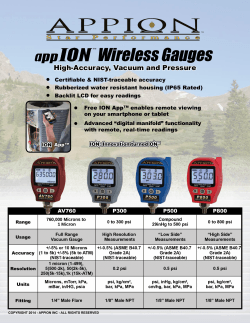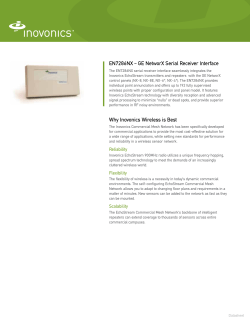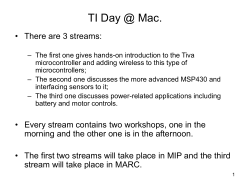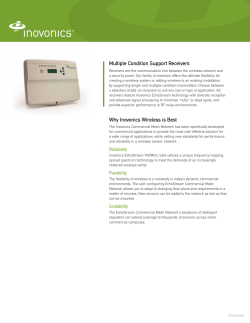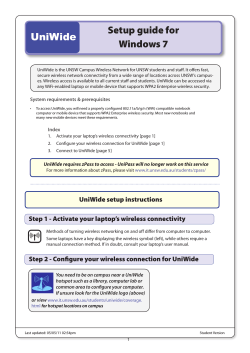
Internet of Things System Design with Integrated
Internet of Things System Design with Integrated Wireless MCUs By: Kavita Char, Senior Product Manager, Silicon Labs Introduction The last few years have seen an explosion in Internet of Things (IoT) devices and connected products such as wireless sensors, smart meters, home automation systems and wearables. The lowered cost of components such as sensors and processors along with increasing wireless connectivity has resulted in many products being made “smart” and able to communicate with each other without human intervention. Successful products must meet often competing requirements including low power consumption, long wireless connectivity ranges and higher processing power. This paper explores how ARM®-based wireless microcontrollers can meet the most demanding requirements of IoT systems. IoT Sensor Node Requirements The network topology of IoT systems is comprised of simple nodes that collect and transmit a limited amount of data to a central controller or gateway which provides connectivity to the Internet and cloud services. Nodes and gateways must be designed to minimize power consumption, provide reliable and robust network connections and extend wireless connectivity range as far as possible. Typical Wireless Metering Architecture Internet of Things System Design with Integrated Wireless MCUs 0 At the heart of IoT systems is a processor unit or microcontroller (MCU) that processes data and runs software stacks interfaced to a wireless device for connectivity. Requirements for both the MCU and wireless device are specific to the end application and system requirements. Advanced IoT sensor nodes consolidate sensor functions and use either an 8-bit MCU or a 32-bit device to run a small radio frequency (RF) protocol stack. These devices are typically battery powered and connect to gateways where heavier processing and data transmission occurs. Sensor Nodes typically transfer small amounts of data and often have to operate on batteries for several years. The devices must also be portable, reliably connected and able to operate under varied environmental conditions regardless of RF interference or physical barriers. Because these devices are part of networks, the setup of networks, aggregation of sensor data and display of information must also be considered. The combined selection of the appropriate MCU and wireless or RF connectivity for these devices as well as development tools and software stacks for application development are critical to their successful design. Selecting a Microcontroller (MCU) Sensor node selection is largely a factor of the function and purpose designers are trying to fulfill. For a simple end sensor node that senses and transmits data a few times a day, an 8-bit MCU might be the correct answer. However, for advanced end nodes or gateway devices that build in intelligence or need to run an RF protocol stack or other sophisticated algorithms, a 32-bit MCU is a more appropriate choice. Some 32-bit MCUs such as those based on the ARM® Cortex®M4 core also include a floating-point unit (FPU) that proves useful for implementing complex algorithms. The higher processing capacity of 32-bit MCUs enables them to complete processing sooner in order to enter sleep mode and preserve power. Additionally, the larger flash and RAM sizes available with 32-bit MCUs allow designers to implement the entire networking stack and application code on the MCU without needing an additional processor in the system. ARM Cortex-M4 based 32-bit MCUs include an FPU with a DSP instruction set. Matrix multiplication, used in monitoring applications that use multiple sensors to get a more accurate reading than individual sensors, is an operation where fast single-cycle MACs (multiply-accumulate) significantly Internet of Things System Design with Integrated Wireless MCUs 1 reduce the computation time. A common algorithm to correlate the sensor readings is the Kalman Filter, which relies heavily on matrix multiplications. Developing applications becomes simpler with the integrated FPU. 32-bit floating-point operations are executed in hardware and the algorithms can be written directly with floating point values, taking advantage of the great dynamic range and precision of floating point numbers. Code can be more easily developed by removing the need for overflow checks needed with fixed-point processors. A good example of where ARM Cortex-M4 based MCUs are useful is when a device combines GPS, accelerometer and gyro measurements to improve location accuracy. Selecting the Appropriate Wireless and RF Connectivity Solution Considerations for selecting the RF protocol/technology are link budget, energy consumption and cost. Wireless developers must determine whether a Sub GHz or 2.4 GHz transceiver will best serve their application needs. Given the high profile of 2.4 GHz wireless standards such as Bluetooth® and Wi-Fi™, many manufacturers assume that 2.4 GHz is the de facto transceiver frequency of choice. Wi-Fi provides high data rate connectivity and is the most widely used protocol for bandwidth-intensive applications such as wireless cameras, while Bluetooth provides easy point-topoint connectivity with smart phones, which most people use to control their connected home applications. Transceivers based on 2.4 GHz offer high data rates (greater than 1 Mbps) and a small antenna (less than one-third the size of a 900 MHz antenna) and are suited for short-range consumer electronics devices. However, a 2.4 GHz radio has limited range, poor wall penetration and higher power consumption. The high data rates require a wider receiver channel bandwidth, which further limits the sensitivity and range. In addition, the 2.4 GHz spectrum is crowded and subject to significant interference from Wi-Fi devices, Bluetooth nodes and microwave ovens. Many IoT sensor nodes have relatively low data rate requirements. For these applications, sub-GHz radios offer substantially higher range than 2.4 GHz radios. Sub GHz radios also have much lower power consumption and can provide connectivity for devices that must operate for years on a single battery. These factors, combined with low system cost, make Sub GHz transceivers ideal for low data rate applications that need maximum range and multi-year battery life, such as smoke detectors, door/window sensors and outdoor systems such as weather stations and asset tracking. One of the main advantages of using Sub GHz wireless is its long-range capability and ability to effectively pass through walls and other barriers. Narrowband transmissions can transmit data to distant hubs, often several miles away, without hopping from node to node, thus reducing the cost Internet of Things System Design with Integrated Wireless MCUs 2 of deployments with fewer base stations/repeaters. RF waves at lower frequencies can travel longer distances for a given output power and receiver sensitivity. Achieving good range depends on the antenna gain, receiver sensitivity and transmitter power. The antenna gain is usually limited by cost and device form factor. Receiver sensitivity sets the lower limit on power that can still be received and understood and receiver sensitivity determines how well it can distinguish the desired transmission from other signals and noise in the area. Thus, having a receiver with both good sensitivity and selectivity makes it possible to achieve longer range. A primary factor affecting radio sensitivity is the data rate. The lower the data rate, the narrower the receiver bandwidth is and the greater the sensitivity of the radio. On the transmitter side, range is determined by the output power level. A 6 dB increase in link budget will double the range in an outdoor, line-of-sight environment. However, regulatory standards limit the allowed output power, and increasing the transmitter power also increases the current consumption, which can have a negative effect on battery life. While many of the existing Sub GHz networks use proprietary protocols and are closed systems, the industry is moving towards standards based, interoperable systems. The IEEE 802.15.4 standard is gaining popularity worldwide and is being adopted by various industry alliances such as Wi-SUN and ZigBee. Designers should also consider a transceiver’s support for mandatory features in Sub GHz bands defined in the 802.15.4 standard. Silicon Labs’ family of EZRadioPRO Sub GHz transceivers have shown 8 to 10 miles of range in both high frequency bands and low frequency bands using standard GFSK modulation. A unique feature of EZRadioPRO is the ability to support ultra-narrow band applications all the way down to 100 bps in a 200 Hz bandwidth. This allows extremely long range communication with standard GFSK modulation for low data rates. Transceivers with programmable data rates such as EZRadioPro allow developers to trade off higher data rates and sensitivity to fine tune the data rate so the radio transmits in the least amount of time. Simplifying Design with Integrated Components Thus far we have discussed MCU and wireless requirements separately. For an IoT system, however, the combination of MCU and wireless device selection and their interaction must be considered together. Instead of using discrete components, designers now have the ability to make use of integrated devices that combine MCUs and transceivers. By taking advantage of chips that integrate the two devices, designers do not have to worry about interconnections between the radio and MCU, making for simpler board design, more straightforward design processes and less susceptibility to interference due to shorter bond wires. Designers are also able to rely upon a fully Internet of Things System Design with Integrated Wireless MCUs 3 tested wireless MCU solution as a starting point for their development. Examples of devices that fulfill these criteria include the Silicon Labs EZR32™ family of wireless MCU devices. By making use of single chips that combine ARM Cortex-M based MCUs and radio transceivers, board component count, board layout and overall cost can be reduced. Devices such as the EZR32 wireless MCUs from Silicon Labs integrate ARM Cortex-M3 or Cortex-M4 MCUs with EZRadio and EZRadioPRO transceivers. In addition to ensuring that transmitters provide sufficient power and receivers provide the necessary sensitivity, designers should also make sure the necessary peripherals and communication interfaces are supported. The high power +20dbm transmitters and receiver sensitivity of up to -133dBm of EZR32 wireless MCUs makes them ideal for low data rate and long range applications. Meeting Low Power Requirements One of the main considerations in IoT implementations is the power consumption of the whole system. Typical applications run on batteries that are expected to last for up to 20 years. In most of these applications, the MCU typically stays in low-power sleep mode for a dominant portion of the time, waking up only once in a while to read sensors or to transmit and receive some data. There are two aspects to the power consumption of the MCU subsystem – dynamic power consumption when the MCU is active, which is proportional to the clock frequency, and the static power related to the leakage current (mostly constant) that plays a bigger role in sleep states. Thus, the total power consumption is affected by the active mode current, the sleep mode current and the amount of time spent in active mode. In applications that spend the majority of the time off, sleep current can be even more important than active current. With higher processing speeds, 32bit MCUs can conserve power by completing processing tasks faster and entering sleep mode sooner. ARM Cortex-M4 based MCUs with an integrated FPU can further reduce the processing and run-time of complex algorithms. The wireless radio transceiver current consumption in sleep mode, transmit and receive mode are also important factors in determining overall system power consumption. Selecting devices that allow for peripherals to interact with each other and for sensors to be monitored without waking the CPU can greatly reduce the system’s total power consumptions. The integrated EZR32 wireless MCU is an example of such a device, with a peripheral reflex system that allows peripherals to interact with each other without waking up the CPU and low energy sensor interface that allows up to 16 sensors to be monitored while the CPU is in deep sleep mode. The new Preamble Sense Mode of the EZRadioPRO transceivers greatly reduces the channel access time with no degradation in sensitivity while reducing the average receive current significantly. These radios require only 8 bits of preamble to detect a valid transmission, compared to the 32-bit requirement of more traditional Sub GHz transceivers. The radio can automatically wake up from sleep and enter receive mode to evaluate the channel based on preamble detection and only wakes Internet of Things System Design with Integrated Wireless MCUs 4 up the MCU if a valid packet is found. If there is no valid packet, the radio automatically returns to sleep mode without interrupting the host MCU. The combination of MCU and transceiver power saving techniques make integrated wireless MCUs such as the EZR32 from Silicon Labs ideal for battery powered sensor node IoT applications. Accelerating Software Development An important consideration when selecting an integrated wireless MCU for IoT applications is the availability of efficient tools, an integrated development environment and software stacks. For most IoT OEMs, such as lighting and appliance manufacturers, designing and building the application from scratch will require networking, wireless and embedded software expertise. When selecting an integrated MCU designers should evaluate the user friendliness of development tools and the availability of software stacks, device drivers and sample applications that can serve as building blocks for the final product. Additional tools such as radio configuration software, network analyzers and packet trace and debug capabilities can speed development significantly. Many semiconductor suppliers provide some of if not all of the mentioned software tools and components listed above. Silicon Labs has integrated both wireless and MCU development into Simplicity Studio™ to provide one development environment for integrated wireless IoT system development. Silicon Labs Simplicity Studio development platform featuring energy optimization tools Internet of Things System Design with Integrated Wireless MCUs 5 Conclusion IoT applications have demanding requirements such as high performance, best-in-class RF performance for longer range, lower power for battery powered applications, higher level of integration to reduce component count and BOM costs and a comprehensive toolset of software stacks and sample applications. Fortunately, highly integrated wireless MCU products such as Silicon Labs’ EZR32 devices, can provide easy-to-implement solutions that offer the high performance needed to satisfy regulatory standards and consumer needs while providing on-chip features and development tools that make it easier to add wireless connectivity to virtually any embedded application. Learn more about Silicon Labs’ EZR32 Wireless MCUs at www.silabs.com/ezr32 and Internet of Things solutions at www.silabs.com/iot. About Silicon Labs Silicon Labs (NASDAQ: SLAB) is a leading provider of silicon, software and system solutions for the Internet of Things, Internet infrastructure, industrial control, consumer and automotive markets. We solve the electronics industry's toughest problems, providing customers with significant advantages in performance, energy savings, connectivity and design simplicity. Backed by our world-class engineering teams with unsurpassed software and mixed-signal design expertise, Silicon Labs empowers developers with the tools and technologies they need to advance quickly and easily from initial idea to final product. www.silabs.com Internet of Things System Design with Integrated Wireless MCUs 6
© Copyright 2025
![[WCR-300S] How to Change the Wireless Network Name(SSID)](http://cdn1.abcdocz.com/store/data/000232989_1-c13ffbaf9a88e423608ef46454e68925-250x500.png)



